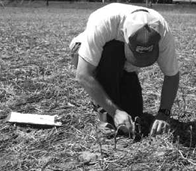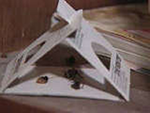IPM Step-by-Step
Step 1: Inspection, Scouting, and Monitoring
The IPM approach requires that pest management decisions be based on reliable information about pest problems. This means that observations must be made to determine the level of, or the potential for, pest infestation. Inspection and monitoring are two related ways of gathering information about pests in the system.
Inspection

Inspection involves regular, planned observations of the system being managed to determine:
• Current pest activity
• The potential for future pest activity based on the presence of
pest-conducive conditions
Pest managers can determine current pest activity through pest sightings, signs of pests (such as droppings) or through monitoring (described below). Pest managers should recognize and document pest-conducive conditions, when all the elements needed for pest survival are in place, regardless of current pest activity.
| Example |
| A restaurant that has inadequate kitchen sanitation, a leaky faucet, ample clutter in the storeroom, a filthy dumpster, and gaps under the doors is ripe for pest infestation. If pests are not already taking advantage of these conditions, it is only a matter of time before they will. |
The purpose of inspection is to gather information that will be used to make pest management decisions. Pest managers performing inspections must be knowledgeable about the types of pests that typically occur in their system and about the conditions that favor pest activity.
A key pest is an important pest that is commonly associated with a particular system. For example, a key pest found in kitchens throughout much of the world is the German cockroach. White grubs are key pests of turfgrass throughout the Midwest. Pest managers must be familiar with the key pests for their geographic area in the systems they manage, so that they can be alert for signs of key pest activity and know what time of year infestations may occur.
The system being managed, the life cycles of the key pests involved, and administrative limitations such as available time, staff, and financial resources will determine the schedule for inspections.
Scouting
 A
component of the pest inspections practiced in turf and landscapes is
scouting for pests. Scouting is usually designed around a key
pest in a system and is a specific inspection practice designed to detect
the presence and abundance of a key pest. Scouting is a protocol for intense,
routine inspection for a key pest that is performed (usually) by the pest
manager.
A
component of the pest inspections practiced in turf and landscapes is
scouting for pests. Scouting is usually designed around a key
pest in a system and is a specific inspection practice designed to detect
the presence and abundance of a key pest. Scouting is a protocol for intense,
routine inspection for a key pest that is performed (usually) by the pest
manager.
An example of scouting in landscape IPM would be inspection of shrubs for the presence of spider mites. If undetected, these tiny mites can threaten plant health. Scouting for spider mites is done by placing a white piece of paper or index card beneath a branch and briskly hitting the branch to dislodge the mites. The pest manager uses the number of mites counted on the paper to decide if a pesticide treatment, or some other control measure, is necessary.
Monitoring
 Pest
Managers use monitoring, like inspection, to gather information
about pest activity on which to base pest management decisions. However,
monitoring is a continuous practice, whereas inspections are performed
at specified intervals. Monitoring involves tools such as sticky traps,
pitfall traps, light traps, etc., to gather information about pest activity
between inspections.
Pest
Managers use monitoring, like inspection, to gather information
about pest activity on which to base pest management decisions. However,
monitoring is a continuous practice, whereas inspections are performed
at specified intervals. Monitoring involves tools such as sticky traps,
pitfall traps, light traps, etc., to gather information about pest activity
between inspections.
Monitoring can also involve pest observations made by people other than the pest manager. For example, in a school, custodians, teachers, and staff will record pest sightings in a log so that they can be communicated to the pest manager.